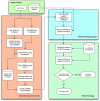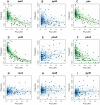Novel analysis of oceanic surface water metagenomes suggests importance of polyphosphate metabolism in oligotrophic environments
- PMID: 21305044
- PMCID: PMC3030594
- DOI: 10.1371/journal.pone.0016499
Novel analysis of oceanic surface water metagenomes suggests importance of polyphosphate metabolism in oligotrophic environments
Abstract
Polyphosphate is a ubiquitous linear homopolymer of phosphate residues linked by high-energy bonds similar to those found in ATP. It has been associated with many processes including pathogenicity, DNA uptake and multiple stress responses across all domains. Bacteria have also been shown to use polyphosphate as a way to store phosphate when transferred from phosphate-limited to phosphate-rich media--a process exploited in wastewater treatment and other environmental contaminant remediation. Despite this, there has, to date, been little research into the role of polyphosphate in the survival of marine bacterioplankton in oligotrophic environments. The three main proteins involved in polyphosphate metabolism, Ppk1, Ppk2 and Ppx are multi-domain and have differential inter-domain and inter-gene conservation, making unbiased analysis of relative abundance in metagenomic datasets difficult. This paper describes the development of a novel Isofunctional Homolog Annotation Tool (IHAT) to detect homologs of genes with a broad range of conservation without bias of traditional expect-value cutoffs. IHAT analysis of the Global Ocean Sampling (GOS) dataset revealed that genes associated with polyphosphate metabolism are more abundant in environments where available phosphate is limited, suggesting an important role for polyphosphate metabolism in marine oligotrophs.
Conflict of interest statement
Figures







Similar articles
-
Polyphosphate--an ancient energy source and active metabolic regulator.Microb Cell Fact. 2011 Aug 4;10:63. doi: 10.1186/1475-2859-10-63. Microb Cell Fact. 2011. PMID: 21816086 Free PMC article. Review.
-
Bacterial microcompartment-directed polyphosphate kinase promotes stable polyphosphate accumulation in E. coli.Biotechnol J. 2017 Mar;12(3). doi: 10.1002/biot.201600415. Epub 2017 Feb 10. Biotechnol J. 2017. PMID: 28105684
-
Distinctive physiology of polyphosphate-accumulating Beggiatoa suggests an important role in benthic phosphorus cycling.Appl Environ Microbiol. 2025 May 21;91(5):e0233024. doi: 10.1128/aem.02330-24. Epub 2025 Apr 30. Appl Environ Microbiol. 2025. PMID: 40304518 Free PMC article.
-
Polyphosphate metabolism in Escherichia coli.Ann N Y Acad Sci. 1994 Nov 30;745:77-91. doi: 10.1111/j.1749-6632.1994.tb44365.x. Ann N Y Acad Sci. 1994. PMID: 7832534
-
Inorganic polyphosphate in the origin and survival of species.Proc Natl Acad Sci U S A. 2004 Nov 16;101(46):16085-7. doi: 10.1073/pnas.0406909101. Epub 2004 Nov 1. Proc Natl Acad Sci U S A. 2004. PMID: 15520374 Free PMC article. Review.
Cited by
-
Polyphosphate goes from pedestrian to prominent in the marine P-cycle.Proc Natl Acad Sci U S A. 2014 Jun 3;111(22):7890-1. doi: 10.1073/pnas.1407195111. Epub 2014 May 27. Proc Natl Acad Sci U S A. 2014. PMID: 24911005 Free PMC article. No abstract available.
-
Fluorometric quantification of polyphosphate in environmental plankton samples: extraction protocols, matrix effects, and nucleic acid interference.Appl Environ Microbiol. 2013 Jan;79(1):273-81. doi: 10.1128/AEM.02592-12. Epub 2012 Oct 26. Appl Environ Microbiol. 2013. PMID: 23104409 Free PMC article.
-
Oligotrophy vs. copiotrophy in an alkaline and saline habitat of Lonar Lake.Front Microbiol. 2022 Aug 4;13:939984. doi: 10.3389/fmicb.2022.939984. eCollection 2022. Front Microbiol. 2022. PMID: 35992701 Free PMC article.
-
Bacterioplankton Dynamics within a Large Anthropogenically Impacted Urban Estuary.Front Microbiol. 2016 Jan 26;6:1438. doi: 10.3389/fmicb.2015.01438. eCollection 2015. Front Microbiol. 2016. PMID: 26858690 Free PMC article.
-
Dissolved organic phosphorus utilization by the marine bacterium Ruegeria pomeroyi DSS-3 reveals chain length-dependent polyphosphate degradation.Environ Microbiol. 2022 May;24(5):2259-2269. doi: 10.1111/1462-2920.15877. Epub 2022 Feb 1. Environ Microbiol. 2022. PMID: 35102659 Free PMC article.
References
-
- Benitez-Nelson CR. The biogeochemical cycling of phosphorus in marine systems. Earth-Sci Rev. 2000;51:109–135.
-
- Tyrrell T. The relative influences of nitrogen and phosphorus on oceanic primary production. Nature. 1999;400:525–531.
-
- Dyhrman ST, Ammerman JW, Van Mooy BAS. Microbes and the marine phosphorus cycle. Oceanography. 2007;20:110–116.
-
- Sebastian M, Ammerman JW. The alkaline phosphatase PhoX is more widely distributed in marine bacteria than the classical PhoA. ISME J. 2009;3:563–572. - PubMed
Publication types
MeSH terms
Substances
LinkOut - more resources
Full Text Sources

